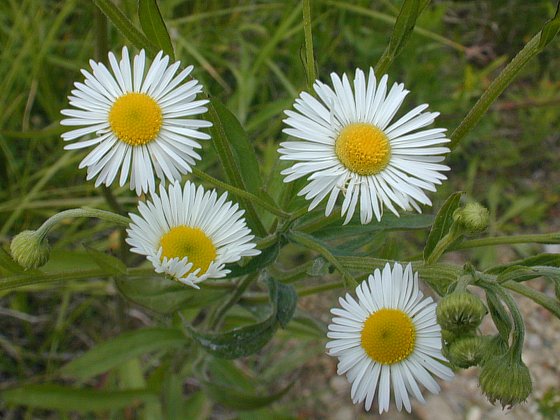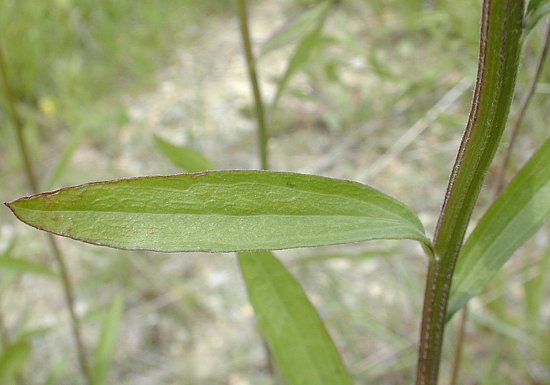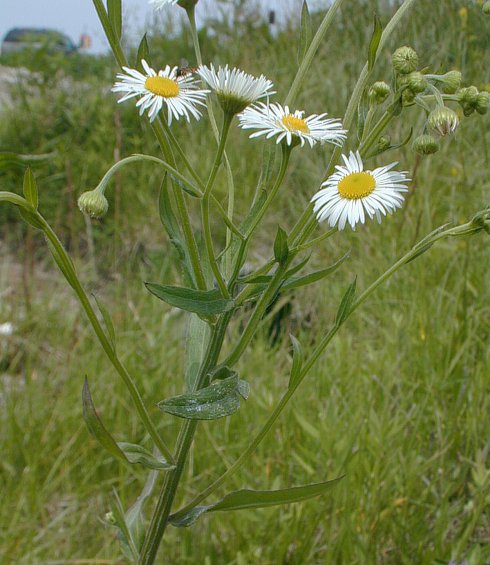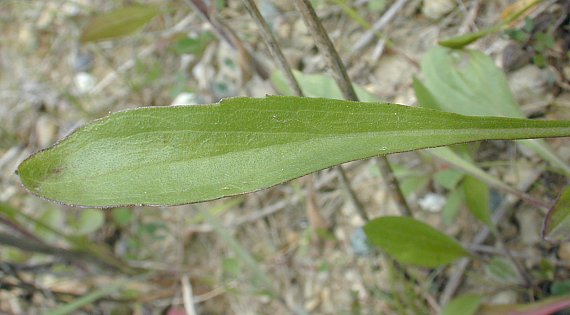Description: This annual or biennial plant is erect and 1-3' tall. It is unbranched along the lower half, while forming lateral stems above that are ascending. The central stem is light green to purplish green and longitudinally grooved along its sides. This stem often has spreading white hairs toward its base, while above these hairs become shorter and more appressed. The lateral stems are similar to the central stem above, except they are less grooved. Alternate leaves are up to 4" long and 16 mm. (2/3") across, becoming smaller in size and more sparse as they ascend the stems. The lowest leaves are oblanceolate in shape with long petioles, while the middle to upper leaves are elliptic to linear-elliptic in shape and they are either sessile or their petioles are short (less than ¼" in length). Some of the larger leaves have sparse coarse teeth along their outer margins. The upper leaf surface is medium green and hairless (or nearly so), while the lower leaf surface is light-medium green and short-pubescent along the central vein. The petioles, when they are present, are light green and more or less pubescent; the petioles of lower leaves are sometimes narrowly winged. The central stem and lateral stems terminate in cymes of flowerheads that collectively span up to 10" across for large plants. Individual cymes are dichotomously branched and somewhat flat-headed; as they mature, these cymes become more open and loose.

Individual flowerheads span about ½" across and they have a daisy-like appearance. Each flowerhead has 40-100 ray florets that surround numerous disk florets. The petaloid rays of the former florets are usually white and linear in shape; sometimes these rays are pink- or purple-tinted. The corollas of the disk florets are yellow, narrowly tubular in shape, 5-lobed, and minute in size; they are densely bunched together. Surrounding the base of each flowerhead, there are linear phyllaries (floral bracts) in 1-2 series. These phyllaries are light green, short-pubescent, and about 3 mm. in length. The branches of cymes and the peduncles of flowerheads are similar in appearance to the lateral stems. The branches of cymes have solitary leafy bracts where they dichotomously divide. These leafy bracts are up to 1" long and linear-elliptic in shape. The peduncles of the flowerheads are up to 4" long. The blooming period occurs primarily from late spring to mid-summer, lasting about 1-2 months for a colony of plants. However, some plants may bloom later in the year. In warm sunny weather, the flowerheads may have a mild pleasant fragrance. Afterwards, the florets are replaced by small achenes that have small tufts of bristly hairs at their apices; they are distributed to some extent by the wind. The bodies of the achenes are about 1 mm. long, light brown, oblong-oblanceoloid in shape, slightly flattened, and short-hairy. The root system consists of a shallow branching taproot with secondary fibrous roots. This plant spreads by reseeding itself, occasionally forming loose colonies.

Cultivation:
The preference is full sun, mesic to dry conditions, and a somewhat
alkaline soil containing
clay or gravel. However, this plant can adapt to soil containing
fertile loam if taller and more aggressive plants are kept away from
it. After the blooming period, the foliage of this plant slowly withers
away while releasing its seeds.
Range & Habitat:
The native Daisy Fleabane is fairly common and it has been reported
from almost all
counties of Illinois (see Distribution
Map).
Habitats include black soil prairies,
gravel prairies, hill prairies, limestone glades, dry savannas, eroding
clay banks, pastures and abandoned fields, areas along railroads,
and roadsides. While Daisy Fleabane is a pioneer species that prefers
areas with a history of disturbance, it is more likely to be found in
higher quality natural areas than the closely related Annual Fleabane
(Erigeron annuus).

Faunal Associations: Primarily small bees and flies visit the flowerheads for nectar or pollen, including little carpenter bees (Ceratina spp.), cuckoo bees (Nomada spp., Stelis spp.), mason bees (Heriades spp.), plasterer bees (Colletes spp.), masked bees (Hylaeus spp.), Halictid bees (Halictus spp., Lasioglossum spp.), Halictid cuckoo bees (Sphecodes spp.), Syrphid flies, bee flies (Bombyliidae), Tachinid flies, flesh flies (Sarcophagidae), and Muscid flies (Robertson, 1929). Less common floral visitors include wasps, small butterflies, and beetles. Other insects feed destructively on the foliage, flowerheads, roots, and plant juices of Daisy Fleabane and other fleabanes (Erigeron spp.). These species include stem-boring larvae of tumbling flower beetles (Mordellistena spp.), the Red-spotted Aster Mirid (Polymerus basalis) and Broken-backed Bug (Taylorilygus apicalis), a leafhopper (Empoasca alboneura), the Erigeron Root Aphid (Aphis middletonii) and Leafcurl Plum Aphid (Brachycaudus helichrysi), larvae of the Aster Leafminer Fly (Calycomyza humeralis), larvae of the Lynx Flower Moth (Schinia lynx) and other moths, the Snakedweed Grasshopper (Hesperotettix viridis) and other grasshoppers, and the Four-spotted Tree Cricket (Oecanthus quadripunctatus). For a more complete listing of these insects, see the Insect Table. Mammalian herbivores occasionally browse on the foliage and flowerheads of these plants. This includes deer, rabbits, groundhogs, sheep, and other livestock.

Photographic
Location:
The photographs were taken of plants at an eroding clay bank along a
road near Urbana, Illinois.
Comments:
Daisy Fleabane (Erigeron
strigosus) resembles Annual Fleabane (Erigeron annuus),
but robust specimens of these two species are fairly easy to
distinguish. Daisy Fleabane has fewer and more slender leaves than
Annual Fleabane, and the hairs along its middle to upper stems are
short and appressed, rather than long and spreading. Another species,
Marsh Fleabane (Erigeron
philadelphicus),
differs by having slightly larger flowerheads with more ray florets
(100-300), and wider leaves that clasp the stems. In addition, Marsh
Fleabane has only spreading hairs
along its stems. While the fleabanes (Erigeron spp.)
are often dismissed as 'weeds' because of their ubiquitousness during
the summer, they are actually rather attractive plants that are
beneficial to many small insects that have important roles in the
functioning of the ecological system. As pioneer species, fleabanes are
also
useful in providing early cover for exposed ground, thereby reducing
soil erosion.